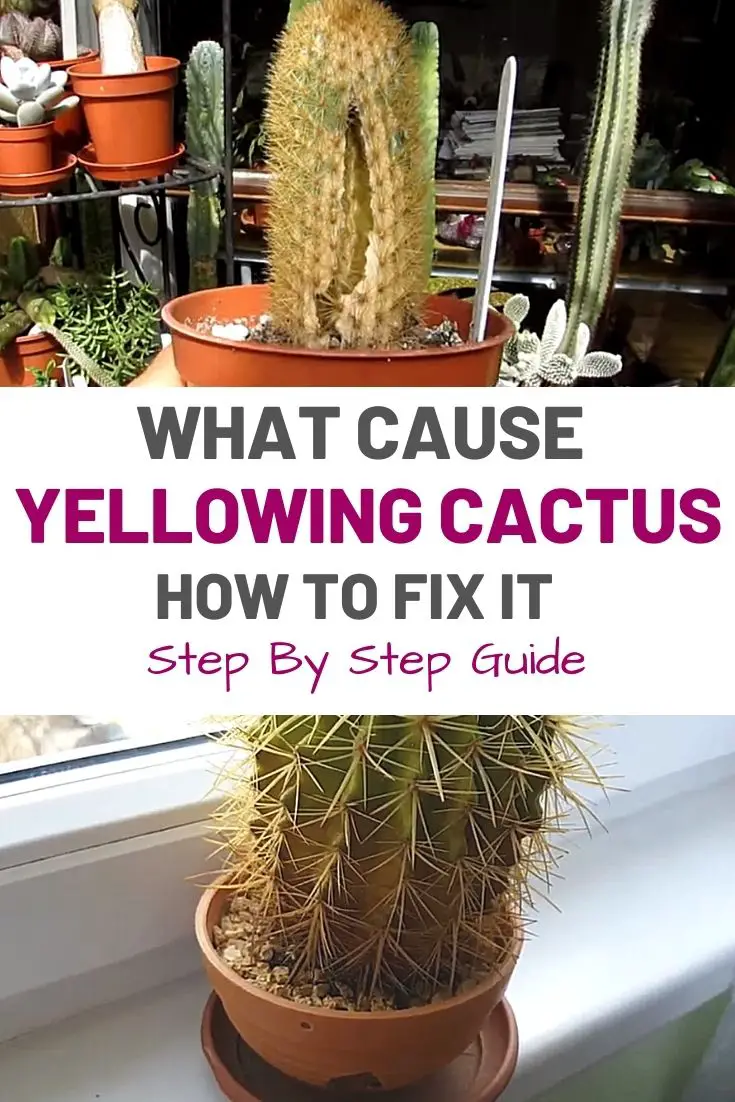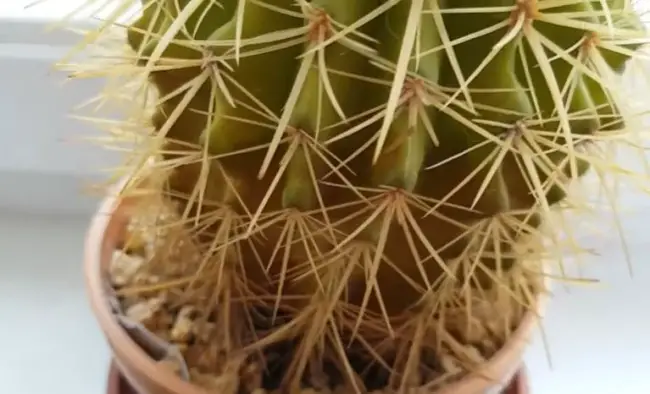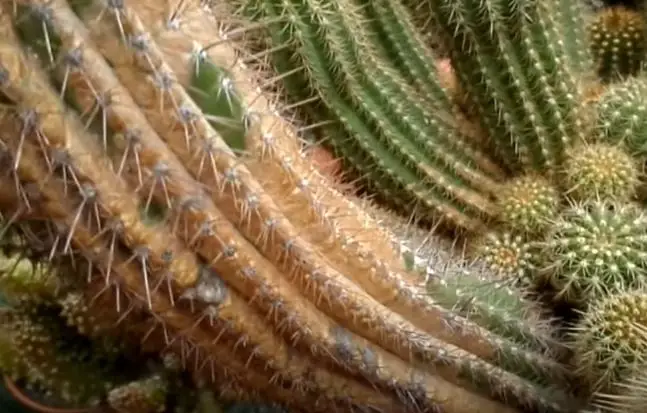Some people think that cactus is one of the easier plants to keep alive because they are so small and take up very little space in your house. But these plants can actually be tricky and temperamental if you didn’t take good care of them.
Cactus can survive well in the desert, which shows that their vitality is very tenacious. Many novice flower growers will choose such a strong self-survivability plant to plant in their houses.
However, the growth environment of domesticated cactus is still very different from that of nature, which causes some problems in the cultivation process of cactus, especially when they get yellowing. Today we will take a look at the reasons and solutions for the yellowing cactus.
What Does it Mean When Cactus Turns Yellow?
If you are planting cactus in your house and see one of them is starting to turn into a yellowish or brownish color, some improper caring may have happened to the plants. The yellow color may sometimes happen at the base or bottom of the plant, on the top, or in the middle. If you spotted any yellow part on your cactus, it means something is going wrong, and you need to take action right away to solve the problem and save your plant.
1. Rotting Yellow or Dewy Leaves
This one is probably one of the most common symptoms, and that is because it is overwatering. The cactus does not need a lot of water. The way they live is you water them thoroughly, and then you may leave them alone until they are completely dried out.
If you struggle with over-watering your cactus, I would suggest putting them in pots with holes in the bottom for drainage because if you don’t do that. You are putting too much water in your plant. The water will sit in the bottom of the pot, which affects the top of the plant, where it will start going yellowish. Something may get rot and fall off.
If your cactus is sitting in a pot without a hole at the bottom, you can try to put some rocks at the bottom of your pot. You shouldn’t just put a few large rocks, but you should put them in various sizes.
Depending on the size of your pot, you can put an inch of rocks at the bottom so that the roots stay above those rocks. By doing so, any extra water will sit in the bottom of the pot, and this will not kill your plant.
2. Yellow Shriveled Leaves
The shriveled leaves are happening due to the under-watering o your plant. This is a pretty easy one to fix if you catch it early enough.
Leave look dry and just shriveled up. They might discolor a little bit, and that’s a sign of under-watering. Some cactus that do not have a substantial root base may get underwater because their root can’t reach a lot of the water.
3. Yellow Fungus
The yellow fungus is from too much humidity in the room where your plant is living. I had this jade plant in my bathroom, which is a very humid environment, and I’m not really aware of this in the first place since I thought they are tropical plants, and tropical plants should like humidity, and they should be able to live well in the bathroom. But I was wrong.
There are tropical plants like pothos, rubber plants, or ferns that like the humid environment.
But is not for a jade plant. I have a few jade plants in the bathroom, and they got that white fungus because they do not like humidity.
What Causes Cactus To Turn Yellow and How To Fix?
Many factors can cause the cactus to turn yellow and mushy. Those factors include overwatering, underwater, sunlight, soil, fertilizer, ventilation, humidity, and pest.
A healthy cactus will have minimal dry, dying leaves in the base. It often will happen to a cactus due to it doesn’t get a lot of suns. However, if you notice a certain part of your cactus starts to turn yellow, that will be some problems for your plant. You need to figure out what’s causing the issue and fix the issue immediately.
Here are some of the issues and things that you can do to fix them.
1. Underwatering
Another major cause of cactus yellowing is excessive watering. This happens when the cactus does not get enough water to stay hydrated. When this happens, the plant’s cells don’t get enough water to make the food the plant needs to grow and stay healthy. As a result, the plant is unable to produce food from light, and its leaves turn yellow.
Watering the cactus frequently is the best way to keep it from becoming too wet. How much water a cactus needs depends on its size, type, and where it is. Cactus, for example, require less water than plants that grow in wetter environments. Using quick-draining soil and keeping track of how long it takes for the soil to dry out can also help keep plants from becoming overly wet.
If your cactus is turning yellow due to a lack of water, give it a thorough watering right away and make sure it stays hydrated from then on.
2. Overwatering
One of the most common causes of cactus yellowing is an excess of water. Cactus are especially vulnerable because they do not receive much rain or humidity and grow naturally. If you overwater the cactus, the roots will become soaked. If there isn’t enough oxygen, the plant won’t be able to absorb the nutrients it requires to grow properly. This can cause the leaves and stems to turn yellow and die.
Remember that if you grow your cactus in a soil-based potting mix, it’s easy to overwater them. Soil-based potting mixes retain water better than others, so you don’t have to water them as frequently. If you’re not sure how frequently your cactus should be watered, you can do some research online or seek advice from a local gardening expert.
3. Sunlight
One of the most common causes of cactus yellowing is sunlight. Excessive direct sunlight can dry out and burn a cactus, turning it yellow. If the plant is exposed to too much sunlight, it may not be able to obtain enough water from its roots to remain healthy. This can also cause the cactus to change color.
You should keep an eye on how much sunlight your cactus receives. Some cactus thrive in bright light, while others thrive in areas with more shade. If you’re growing cactus outdoors, make sure they don’t get too much direct sunlight. You can also use netting or shade cloths to protect plants that aren’t as hardy from direct sunlight.
4. Drought and dehydration
Contrary to overwatering, this is caused by the fact that the plant is underwatering, or you may only water the top of the plant, but the soil is not getting enough water.
This will affect the cactus’s water absorption, resulting in dark yellow leaves without luster and gradually withering and falling off from bottom to top.
At this time, you should be watering the soil and making sure the soil is soaking in enough water. Then leave the plant to let it recover gradually.
5. Fertilizer
It’s important to know when and how much fertilizer to put on your plants because too much or too little can make them turn yellow. If there aren’t enough nutrients in the soil for the cactus to take in, it will turn yellow to try to get what it needs from somewhere else. Use a fertilizer with the right amounts of all the nutrients plants need to avoid this problem.
Also, it is important to only use the amount of fertilizer that is recommended. If too much is used, the cactus may suffer from nutrient burn and turn yellow. Also, using organic fertilizers can help keep the cactus healthy and stop it from turning yellow from getting too many chemicals from synthetic chemical feedings.
- Underfertilization – If the soil has not been changed for a long time, it may lack fertilization. You may take out the plant to repot to another pot or change the soil with fertilizer and put back the plant into the same pot with new fertilizing soil.
- Overfertilization – Due to excessive fertilization, the old leaves may gradually fall off. At this time, stop fertilization and increase the water to an appropriate volume, immediately invert the pot, and rinse the soil lumps with water.
6. Ventilation
Ventilation is important for cactus to stay healthy because it helps them take in carbon dioxide and let out oxygen. If cactus leaves don’t get enough oxygen, they can turn yellow if there isn’t enough airflow.
It’s important to give cactus a lot of fresh air and space to move around. You can do this by putting a fan near them or opening windows in your house or garden shed so that air is always moving around them. Also, making sure there is enough space between plants will help them get enough airflow.
Drying air also can cause falling leaves and yellowing cactus. If the air is too dry, you can spray water to increase the air humidity.
7. Humidity
Humidity is one of the main reasons why cactus turn yellow. How well the plant can take in water from the air is the main factor in its health and color. When it’s too humid or there isn’t enough airflow, cactus have trouble taking in and storing water, which causes their leaves to turn yellow.
It’s important for people who care for cactus to keep the humidity around their plants at the right level. This can be done by adding more airflow or making changes to when the plants are watered. If you live in a place with a lot of humidity, you should use a dehumidifier.
Changing the humidity and airflow around your cactus will help it stay healthy and full of life for a long time. Make sure your plants look their best by checking them often for signs of yellowing and making changes as needed.
8. High temperature and heat
If the place where you plant your cactus has a high temperature for long hours, then you will need to transfer the cactus to a cool and ventilated place in time. Otherwise, if the plant exposes to excessive heat, the leaves may get yellow after some time.
9. Too much shade
If your cactus plants are placed in cool places for a long time, this may cause insufficient sunlight absorption for the plants. You will need to move them to some ventilated sunny places in time to warm them up.
10. Soil
Soil is a big part of a cactus’s health and can cause it to turn yellow. If the soil isn’t set up right, cactus won’t get the nutrients they need to stay healthy. If the soil around a cactus has too much or too little water, the plant won’t be able to get the minerals it needs for photosynthesis, which can cause it to change color.
Your soil’s pH balance is also important if you want your cactus to stay healthy and grow well. Too much acidity can make the plant not get enough nutrients and change its color. Use potting mix made especially for cactus to make sure your plant gets all the minerals it needs. This kind of soil has everything plants need to grow and change color well.
The loss of chemical elements in the soil causes the soil to become acidic. If you plant your cactus into the soil, your plant may grow yellowish. To rectify the issue, you need to apply alkaline solutions such as calcium, magnesium, and phosphorus into the soil to lower the acid level
No matter how much light you give your plants, they won’t grow if the soil isn’t good enough. To make sure your cactus does well in its new home, you need to be careful when choosing the soil for its pot. You can keep your cactus green and happy if you work at it and have patience.
11. High density of the plant
If the leaves and branches of your cactus are growing too crowded, they may get a tiny room to grow, and some leaves may turn yellow due to insufficient nutrients.
To resolve this, you must prune your plant to eliminate excessive branches and leaves. Because of the luxuriant branches and leaves can also be easy to cause the leaves to fall off. Besides, you need to pay attention to the ventilation and lighting environment.
12. Unstable room temperature
Due to the changes in the four seasons, the room temperature will change accordingly. To avoid your cactus from getting sick, you need to pay attention to the temperature and adjust the appropriate room temperature if necessary promptly.
13. Pests and diseases
Mealybugs and scale, for example, can hurt the plant and drain its energy. It will start to look wilted and yellow because of this. You may even be able to see where the pests have eaten the cactus in some cases.
If you think there might be bugs on your cactus, you should act quickly. If you don’t take care of them, they can spread quickly and do even more damage. You can get rid of them and keep your cactus healthy by using a mix of organic sprays and insecticides.
Due to the pathogenic bacteria, it is easy to cause leaf spot disease. The branches and leaves will wither if you didn’t’ take care of them. Timely spraying is required for the prevention and treatment of your cactus.
If you keep an eye out for pests and do what you need to do to get rid of them, you should be able to keep your cactus looking its best. Pests can cause a lot of damage, so it’s important to check your plants for signs of them on a regular basis.
However, you need to avoid using strong pesticides or herbicides. If the spraying concentration of pesticides is too strong, it will cause the pollution of toxic gases and cause yellowing cactus.
You should use pesticides rationally to prevent air pollution as well. You need to make correct judgments and come out with the right solution.
Overall, yellowing cactus can be caused by a variety of factors, such as overwatering, underwatering, too much sunlight, or lack of ventilation. It is important to remember that all plants need the right balance of water, sunlight, and fertilizer to stay healthy. Additionally, soil and humidity levels should be monitored carefully to help prevent pest infestations. Keeping these things in mind will help ensure a happy and healthy cactus.
If a cactus seems to be turning yellow or wilting, it is important to find out why before you do anything. First and foremost, check the soil for signs of overwatering or underwatering. If the soil is dry and cracked, then more water may be needed. If it feels wet or soggy, reduce the watering frequency. Secondly, check if there is too much direct sunlight on certain sections of the plant, which could be causing sunburns or bleaching. Additionally, make sure adequate ventilation and humidity levels are maintained, as this helps keep pest infestations at bay.
By understanding what causes cactus to turn yellow, gardeners can take appropriate steps to ensure that their plants stay healthy and vibrant for years to come! With proper care and attention, any gardener can grow a thriving cactus with beautiful blooms each season!



